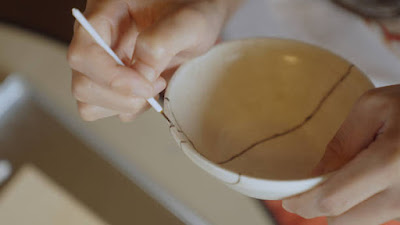Unlocking New Value Through Kintsugi Artwork: "Dripping Gold
Drops" on a Blue and White Flower Vase, Restored by Kiyokawa Hiroki (Photo
courtesy of Heiando Kyoto)
In recent times, there has been a
resurging interest in the ancient Japanese art of kintsugi, a technique used
for mending fractured ceramics. This resurgence can be attributed to a growing
global focus on sustainability, encouraging individuals to cherish and extend
the life of their possessions. However, it's not just the sustainability aspect
that draws people in; the exquisite beauty born from the use of urushi lacquer
and powdered gold is equally captivating. Let's delve into the world of
kintsugi, exploring its origins and its contemporary appeal in Japan.
Kintsugi's Historical Roots
Kintsugi is believed to have
originated during the Muromachi period (1336–1573) in Japan, coinciding with
the rise of the traditional cha-no-yu tea ceremony, known for its ceremonial
serving of matcha green tea. In this tea ceremony, the vessels used held great
significance, and their craftsmanship and design continually evolved. During
this era, ceramics were considered precious and exclusive, reserved mainly for
the elite. Consequently, there arose a need for a method to restore expensive
chipped or broken chawan tea bowls.
The concept of ceramic repair was
introduced to Japan through the kasugaidome technique, which involved binding
broken fragments together with sturdy metal staples. However, this approach
fell short of achieving the desired aesthetic quality. In the pursuit of a more
visually pleasing restoration method, the kintsugi technique was born, with tea
ceremony aficionados embracing the unique patterns that emerged from past
damage. Remarkably, some of the chawan tea bowls repaired using kintsugi during
this period have endured to this day as well-preserved artifacts.
Kasugaidome Artwork: Bowl with a
Foliate Rim, Named "Bakōhan," an Important Cultural Property of
Japan, Tokyo National Museum (Source: ColBase)
Kintsugi in the Modern Age
The traditional kintsugi technique,
evolving from the Muromachi period and reaching its zenith during the Edo
period (1603–1868), relies solely on natural materials native to Japan: urushi
lacquer, rice powder, and mountain soil. The remarkable endurance of items
repaired over two centuries ago attests to the longevity of these natural
materials.
For an extended period, kintsugi was
applied exclusively to high-value tea ceremony equipment. Ordinary people
mended their belongings using yakitsugi, a technique fusing pieces together
with lead glass. However, in the 2000s, kintsugi, previously passed down
through generations as a specialized craft, began to democratize, thanks to
beginner-friendly guides and a newfound appreciation for traditional Japanese
craftsmanship. Additionally, the age of mass consumption brought renewed
attention to environmental stewardship and item longevity, aligning perfectly
with kintsugi's ethos of imbuing new worth into damaged objects.
Some enthusiasts have even expanded
the application of kintsugi beyond pottery to include glass items, further
broadening its reach and fostering a deeper appreciation for this art.
Accessible for Beginners
Historically, kintsugi was exclusively
performed by urushi artisans due to its reliance on urushi lacquer, derived
from the sap of the urushi tree. Although various methods of kintsugi exist,
the fundamental process remains consistent: reattaching broken pieces using urushi
lacquer, filling cracks or chips with a putty made of urushi lacquer mixed with
sawdust or powdered stone, and finishing with a dusting of gold powder. Today,
kintsugi sets comprising essential tools and materials are readily available,
complemented by instructional videos that facilitate individuals in trying
their hand at this art.
Kintsugi demands patience, as the
urushi lacquer requires ample drying time, often extending to two months for
the completion of a piece. For those seeking quicker results, a simpler
alternative involves employing water-resistant craft glue, suitable for
tableware, with acrylic ceramic paint applied over the mend. This approach
offers a rapid and accessible means to achieve a kintsugi-inspired repair.
The proliferation of accessible
options for embracing kintsugi at home has undeniably contributed to its
widespread popularity. In our daily lives, accidents leading to broken items
are inevitable. Kintsugi, with its ability to create fresh beauty from imperfection
while promoting sustainability, is a practice that merits passing on to future
generations."



.jpg)



